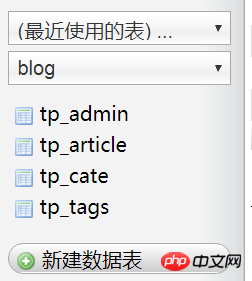
This article mainly introduces the method of thinkPHP5 framework to realize the paging query function, and analyzes the related controllers, templates and other operating techniques of thinkPHP5 to realize the paging query function in the form of examples. Friends who need it can refer to it. I hope it can help everyone. .


Admin.php in the controller file
<?php
namespace app\admin\controller;
use think\Controller;
use app\admin\model\Admin as AdminModel; //使用分页类 取别名解决类名冲突
class Admin extends Controller{
public function lst(){
/* 分页开始 */
$list = AdminModel::paginate(3);
$this -> assign('list',$list);
/* 结束 */
return $this->fetch('lst');
}
public function add(){
//判断页面是否提交
if(request()->isPost()){
//打印接收到的参数
//dump(input('post.'));
$data = [ //接受传递的参数
'username' => input('username'),
'password' => md5(input('password')),
];
/*验证开始*/
$validate = \think\Loader::validate('Admin');
/* scene('add') 在add页面添加验证应用 */
if(!$validate -> scene('add')-> check($data)){
/* 验证失败打印 */
$this -> error($validate->getError());
die;
}
/*结束*/
/* Db('表名') 数据库助手函数*/
if(Db('admin') -> insert($data)){ //添加数据
return $this->success('添加成功','lst'); //成功后跳转 lst 界面
}else{
return $this->error('添加管理员失败');
}
return;
}
return $this->fetch('add');
}
}Admin.php in the model file
<?php
namespace app\admin\model;
use think\Model;
class Admin extends Model{
}lst.html
<!DOCTYPE html>
<html>
<head>
<meta charset="UTF-8">
<title>后台</title>
<style type="text/css">
*{
padding: 0;
margin: 0;
}
table{
width: 500px;
margin: auto;
}
.pagination li{
margin: 10px;
float: left;
list-style: none;
}
</style>
</head>
<body>
<p>我是lst</p>
<a href="{:url('admin/add')}" rel="external nofollow" >跳转add</a>
<table border="1" cellspacing="" cellpadding="">
<tr>
<th>ID</th>
<th>用户名</th>
<th>操作</th>
</tr>
<!-- 循环数据 -->
{volist name="list" id="vo"}
<tr>
<td>{$vo.id}</td>
<td>{$vo.username}</td>
<td>Data</td>
</tr>
{/volist}
</table>
<!-- 分页器 -->
{$list ->render()}
</body>
</html>The above is the detailed content of Implementation method of paging query function in thinkPHP5 framework. For more information, please follow other related articles on the PHP Chinese website!




